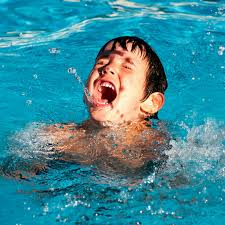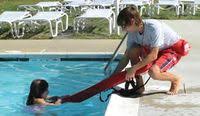ESD: What is it? Part 1 of 2
ESD, also known as Electric Shock Drowning, is a form of drowning caused by an electric current in the water. Where does the electric current originate? It could be your boat, a malfunctioning charger or lighting system. More on this in Part 2 of this series.
I have a fiberglass boat hull – that should protect swimmers – Right??
Yes, but you also have a motor with a metal prop in the water. As a result, this exposes people in the area of the boat to an electrical shock. The shock is greater as they get closer to the source of the problem.
Why is ESD even more dangerous in freshwater?
In freshwater, electrical current passes through the body paralyzing the body muscles. The strongest, most experienced swimmer in the world will not be able to swim through the current field if this happens.
Is there a warning of ESD?
Yes, there is:
- The victim will feel tingling, numbness, pain, and paralysis. That is the first sign of a problem. The closer they get to the source of the current the stronger the sensations will be – and the more paralyzed they will become.
- Initially, the victim will be able to shout, but if they unknowingly try to swim towards the electrical source, this ability will cease as they become paralyzed.
- The ability to “shout” more than once is critical. It is the difference between an ESD, an electrocution victim, and a drowning victim. An electrocution victim may not be able to shout at all. A drowning victim can only shout once or twice before his/her lungs fill with water.
- Typically, if the victim of ESD is not close to the source, he can shout and tell you what is happening. A drowning victim cannot yell as their lungs fill with water.
- Many times the ESD victim looks distressed and not as playful as usual. The muscles will no longer function as normal.
- The situation may turn into drowning once the victim begins to get water in their lungs.
How about Electrocution
- A possible victim will be able to scream, usually only once. The victim’s muscles will cease to function almost immediately.
- There will be a sudden cessation of all activity
- The victim usually rolls on their back with their face out of the water and is not responding if wearing flotation.
- If not wearing flotation, they will likely roll onto their face.
Drowning
- The victim cannot speak or shout
• Reflexive “ladder climbing” with their arms even for an experienced swimmer.
• Looks “playful.”
• Lasts ~60 seconds with an adult and as little as 20 seconds with a child
• Slips below surface
What to do if you suspect an ESD situation
- Keep everyone out of the water – and if they are already in the water – DO NOT allow them to swim back to the dock unless the sensation gets stronger while swimming away from the dock or boat. Remember, the source may be a nearby dock, pump or boat.
- Try to get others in the area to swim away from your dock at least 100 yards and then go to the shore. The electrical current is stronger nearest the source and dissipates as you get away from it.
- Resist the natural impulse to jump into the water to help. You will become a victim yourself. Do NOT jump into the water. Use the Reach, Throw, Row, DON’T GO technique below.
- Protect yourself by using an oar, a float or other non-conducting material to pull the swimmer to safety once the electrical source is shut off See the caption to the right.
- Immediately disconnect all power.
- Take the victim to the hospital to make sure there are no lingering effects that could be dangerous.
In General
- ESD victims are good candidates for successful Cardiopulmonary Resuscitation (CPR).
- Learn to perform CPR and maintain your training.
- To retrieve a person in the water, reach, throw, and row, but don’t go.
- Make sure your children understand the importance of not swimming anywhere there could be electricity. Don’t let them roughhouse on docks. Tell them what to do if they feel a tingling or shock in the water (see below).
I want to test for current myself. Can I do it?
Yes, with my digital voltmeter, put the negative lead to a ground, drop the positive lead into the water, if the needle moves, even slightly – you may have AC Voltage in the water. Having an electrician do the testing is the best way
- Have your boat tested once a year to see if it is leaking electricity, or buy a clamp meter and test it yourself. If you find any problems, have your boat inspected by a qualified electrician.
- Have a qualified ABYC electrician install an ELCI on your boat (refer them to the ABYC E-11 Standard) or use an ELCI in the shore power cord. As an alternative, install an isolation transformer on the boat.
- Test the GFCI/ELCI at least once a month or per the manufacturer’s specifications.
- DO NOT do your own 120-volt AC electrical work on a boat or hire an electrician who is not familiar with ABYC standards to do it. Many of the problems that lead to electrical faults result from the differences between shore and boat electrical systems and standards.
- NEVER dive from your boat to work on underwater fittings when it is plugged into shore power.
- DO NOT use common household extension cords for providing shore power to your boat. Use, and encourage other boaters to use shore power cords built to UL standards. Make sure the connections DO NOT touch the water.
If You Have A Private Dock
- NEVER swim within 100 yards of ANY dock using electrical power!
- If you have not electrified your dock or put an AC system on your boat, weigh the risks carefully before doing so.
- Need electricity on your dock – hire a licensed electrician and make sure the wiring meets the requirements in NFPA 303 and NEC 555. If your dock is already wired, hire an electrician to check that it was done properly. Docks are exposed to the elements, their electrical systems should be inspected at least once a year.
- If you normally run a power cord from your house or garage to charge your batteries, make sure the outlet has a GFCI and include an ELCI somewhere in the shore power cord. See part 2 of this series.
- NEVER swim off your dock without shutting down all shore power to the boat and the dock.
- Even if you adhere to all of these rules, nearby docks can still present a shock hazard. Educate your neighbors and work together with them to make the waterfront safe.
What if…
Someone you were with fell out of a boat without their life jacket – Would you know what to do?
- REACH: Hold on to the dock or your boat and reach your hand, a boat oar, a fishing pole, or whatever you have nearby, to the person. Many times these people have a fear of drowning and they will pull you under. Do not touch metal yourself.
- THROW: If you can’t reach far enough, toss things that float for the person to grab.
- ROW: If you’re in a boat, use the oars to move the boat closer to the person in the water, or call out to a nearby boat for help. Don’t use the boat’s motor close to a person in the water; they could be injured by the propeller
- DON’T GO: Don’t go into the water You will become a victim yourself. Call out for help. Never use a metal ladder or stairs to enter the water when there is an electrical problem
Be careful reaching from the boat or dock – If you are touching metal, you may be a path to ground yourself.
In part two of this series, we will explain more about the GFCI and ELCI.
Where is PWS?
PWS is located in the center of Door County at 7325 St Hwy 57. It is located 1 mile North of County MM (Hwy 42) and South of Sturgeon Bay. Look for the intersection of Idlewild Road.
Want us to address a dock or boat lift topic for you? Feel free to give us a call.









